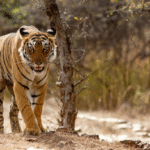— A new seasonal wildlife advisory highlights the period between November and June as the most favorable time for visitors seeking tiger sightings at Rajaji National Park. The report outlines specific months, temperature ranges, and environmental conditions that contribute to improved visibility of tigers and other key wildlife species across the reserve’s varied landscapes.
Peak Wildlife Observation Window
The park, which remains closed during the monsoon season from July to mid-November, transitions into its primary safari period as soon as post-monsoon conditions clear. From November onward, vegetation begins to thin, improving visibility across grasslands, forest corridors, and riverine zones. Temperatures during winter months typically range between 12°C and 25°C, which encourages wildlife movement throughout the day.
From March to June, rising temperatures—reaching up to 38°C–40°C—concentrate animal activity near natural water sources. This seasonal pattern increases the likelihood of observing tigers, elephants, leopards, and other mammals during morning safari drives.
Safari Operations and Visitor Access
Safaris are conducted twice daily across designated tourism zones. Morning safaris generally run between 6:00 a.m. and 9:00 a.m., while afternoon sessions operate between 2:00 p.m. and 6:00 p.m., with minor adjustments made according to daylight hours.
The Motichur Range remains recognized as the leading area for frequent tiger activity due to its dense forest cover, prey availability, and strategic ecological corridors.
Standard jeep safari fees begin at approximately ₹900 per person, with separate guide charges starting near ₹500. Due to controlled vehicle limits and high seasonal demand, advance booking is strongly encouraged.
Broader Biodiversity Observations
Beyond tiger sightings, the advisory notes that Rajaji National Park hosts over 400 recorded bird species, making the winter months particularly favorable for ornithology enthusiasts. Summer conditions, by contrast, provide clearer opportunities to observe herbivores and predators congregating near water bodies.
Visitors can expect a diversity of landscapes, including riverbeds, sal forests, grasslands, and foothill terrain. These habitats contribute to the park’s biodiversity and support a wide range of viewing points, including grassland clearings, forest edges, and natural water sources.
Visitor Planning Recommendations
The advisory emphasizes that the November–June window consistently aligns with the natural behavioral patterns of the park’s wildlife. Early morning drives during this period provide the strongest probability for notable sightings, including tigers and elephants.
The proximity of the park to Haridwar and Dehradun further enhances accessibility, enabling visitors to plan short-duration or extended wildlife excursions with ease. Travelers are encouraged to secure bookings early, review seasonal regulations, and adhere to all conservation-linked guidelines while inside the protected area.
About the Park
Rajaji National Park is one of northern India’s major wildlife reserves, spanning the Shivalik range and the Indo-Gangetic plains. It is known for its tiger population, Asian elephants, rich bird diversity, and varied topography that supports numerous flora and fauna species.
Contact Info:
Name: Rajaji National Park
Email: Send Email
Organization: Rajaji National Park
Website: https://www.junglesafarirajajinationalpark.com/
Release ID: 89176509
If you detect any issues, problems, or errors in this press release content, kindly contact error@releasecontact.com to notify us (it is important to note that this email is the authorized channel for such matters, sending multiple emails to multiple addresses does not necessarily help expedite your request). We will respond and rectify the situation in the next 8 hours.
